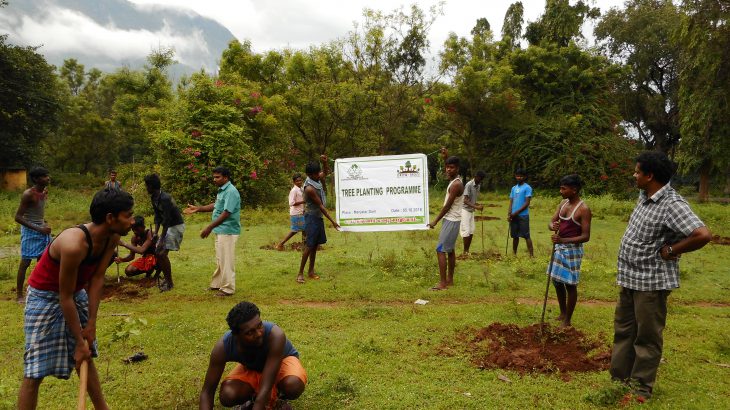Tremendous Green Investment – Larsen and Toubro InfoTech to plant 100,000 trees by 2020 in association with Grow-Trees
Larsen and Toubro Infotech (LTI) is demonstrating tremendous green leadership by supporting the unique social impact-based projects created by Grow-Trees such as Trees for Forest and Wildlife, Trees for Tribal Communities, etc. 100,000 trees plantation initiative supported by LTI is expected to offset approximately 2 million kilos of carbon per year on maturity and will create around 8000 workdays of jobs for the rural communities. Being a part of the Larsen and Toubro (L&T) Group, sustainability has been ingrained in their DNA. LTI has been disclosing its sustainability performance since 2009. Now, LIT is going to additionally invest in the ecological preservation and regeneration with the plantation of 100,000 trees – spread across Maharashtra, Tamil Nadu and areas close to Puducherry. They are really keen to work for the upliftment of tribals and preservation of biodiversity and hence, they have invested in our 3 projects – Trees for Tribals, Nimbhora, Maharashtra, Trees for Biodiversity, Manjalar, Tamil Nadu and Trees for Biodiversity in coastal Kaliveli wetland and lagoons in Tamil Nadu. The project, Trees for Tribals in Nimbhora, Maharashtra, with an aim to plant 67,500 trees in the panchayat lands of the village of Nimbhora-Tirzada, Tehsil Kalamb, District Yavatmal, Maharashtra, recognizes the role of the forests in fulfilling basic needs of tribal communities. Tribal communities extract basic necessities like clean water, food, medicines, shelter and even recreational opportunities from forests. They practice shifting cultivation in the forests and collect the minor forest products to support their livelihood. Forests also contribute to the cultural/spiritual beliefs of the people, making the forest ecosystem an indispensable part of the daily lives of the people. Severe droughts are a regular phenomenon in the plantation area of Nimbhora, Maharashtra. This threatens not only agricultural productivity but also other types of activities like livestock rearing. The shortage of fodder, water, and other monetizable assets consequently forced people to sell their animals at huge losses which fetched them food, livelihood, and labor during farming. Furthermore, trees regulate the climate to prevent drought-like situations, thereby preventing losses to the community. The other plantation project of 10,000 trees in the catchment areas of the Manjalar dam in Devathanapatti forest division, Theni district in Tamil Nadu will help in improving water catchment with the planting of native trees. The growth of these native plants and fruits will restore animal habitats. Trees will also trap windblown dust before it enters steam and lakes and therefore, maintaining the purity of surrounding Manjalar dam. The plantation of these trees in this site will enhance the livelihood opportunities of the local communities and help them overcome poverty. Thirdly, the project Trees for Migratory Birds for planting 7,500 trees will be implemented in the Panchayat-owned lands in the catchment area of the coastal Kaliveli wetlands and lagoons in Tamil Nadu, close to Puducherry (Pondicherry) comprising 10 villages namely, Kolathur, Komadipattu, Vada, Agaram, Marakkanam, Koonimedu, Kurumpuram, Vandipalayam, Oorani and Kodur of Villupuram district. This project has the major motive of improving the natural habitat of migratory birds and the Kaliveli Tank is a semi-permanent, fresh to brackish water lagoon, which empties into the sea through a narrow channel connecting the tank with the Yedayanthittu Estuary to the northeast. Yedayanthittu estuary lies about 3 km away from this tank. Until about 25 years ago, the entire region was heavily forested, but almost all the forest has been cleared, and the tank and estuary are now surrounded by cultivation and scrubby thorn woodland. The tank and the estuary are extremely important staging and wintering areas for a wide variety of migratory waterfowl (Pieter 1987, Scott 1989). The area regularly holds over 30,000 ducks in winter; and 20,000-40,000 shorebirds and 20,000-50,000 terns during the migration period. Pieter (1987) noted about 40,000 birds in the Tank, and another 20,000 in the estuary. In March and April, as the water level recedes, the lagoon attracts large congregations of pelicans, herons, egrets, storks, and ibises. Spot-billed Pelican Pelecanus philippensis is a regular visitor in flocks of 30-200 individuals, and Greater Flamingo Phoenicopterus ruber sometimes occurs in very large numbers. This vision for the plantation of 100,000 is an example of improving the most vulnerable sections of society through the most affordable and reliable climate change solution – trees. This is truly a great event to create alternative sources of income for the local villagers through not only timber produce but also through non-timber forest products like fruits, nuts, fibers, medicinal plants, etc. The villagers will be involved in plantations from the very beginning to the maturity stage as they are the ones who hold the supreme knowledge about their forests. We are really glad to be able to partner with a global leader like LTI and look forward to such impactful associations in the future. To plant trees and empower local communities of India, click here – http://bit.ly/2MrO4bU |
